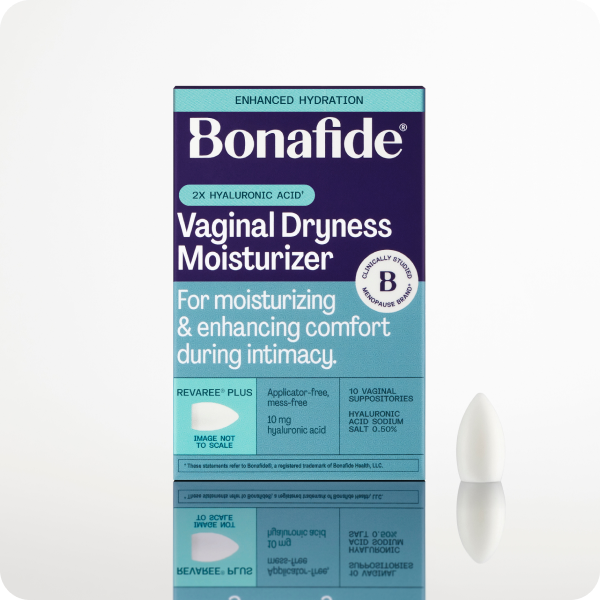Painful sex, or what the medical community often refers to as dyspareunia, can be taboo to talk about. But it's more common than you may think. Estimates show that up to 45% of perimenopausal and menopausal women report discomfort during sex, including pain or discomfort during penetration.1 And since the topic is still considered to be so taboo, the true numbers could likely be even higher.
Addressing the issue of painful sex and pain upon insertion depends largely on a woman's specific symptoms and what's causing them. While you've likely heard about potential fixes for these symptoms, like vaginal lubricants, moisturizers, or hormone therapy treatment(s), pelvic vibration is another option that could be beneficial – particularly if vaginal entry or insertion pain is your primary symptom.
Here we take a closer look at what pelvic vibration is and how it works. Plus, we also discuss other strategies you can employ to help make sex feel more comfortable when you're experiencing uncomfortable vaginal symptoms associated with perimenopause or menopause.
What Causes Painful Sex or Discomfort with Vaginal Insertion?
Sex or vaginal insertion can hurt for a number of different reasons. Among perimenopausal and menopausal women, the most common culprits often include vaginal thinning, a shortening of the vagina, a narrowing of the vaginal opening and dryness, which stems from shifts and declines in the hormone estrogen.2
Other things can factor in too, and they aren't always related to menopause or aging. These additional causes can include:3, 4
- Pelvic floor dysfunction, a condition marked by overactive, restricted, or tender pelvic floor muscles that cause pain around the vaginal entrance and make penetration difficult or even impossible. It affects around 1 in 4 U.S. women and may become more prevalent with age.
- Lack of arousal, which can prevent vaginal tissues from becoming adequately lubricated leading up to sexual activity.
- Infections, including yeast infections or bacterial vaginosis.
- Injuries or trauma from childbirth, pelvic surgery, or an accident.
- Certain conditions including endometriosis, uterine prolapse, uterine fibroids, ovarian cysts, or even certain skin conditions.
Pelvic Vibration for Easing Vaginal Insertion Pain
When most people talk about vibrators or personal massagers, it's usually in the context of achieving an orgasm. But pelvic vibrating devices can also be beneficial for managing painful sex or pain with insertion, particularly for women experiencing pelvic floor dysfunction, research suggests.5 Vibration’s mechanism of action is that it helps to improve pelvic circulation and enhances blood flow to the genitals, increasing vaginal arousal and natural lubrication.6 "We understand vibration can provide relaxation, increase blood flow, and increase arousal, if desired. If physical arousal is desired, this can allow for muscles to relax as well as for less pain with penetration," explains pelvic floor specialist Corey Hazama, DPT.
To support these pelvic benefits, there are a variety of devices available for women to explore, including external genital massagers, clitoral vibrators or other types of sexual enhancers. One example of a beneficial device includes Kiwi. Kiwi is a vibrating vaginal entry pain massager with science-backed features from our friends at The Pelvic People, which has been designed to help relax pelvic floor muscles and decrease pain with insertion.6 "The Kiwi was created to address underlying musculoskeletal dysfunction while breaking the cycle of pain, anxiety, or avoidance, because Kiwi feels good to use," says Emily Sauer, founder and CEO of The Pelvic People.
Designed to be used at home, Kiwi can be used prior to vaginal penetration to relax and prepare pelvic floor muscles or may be used regularly or daily as part of a pelvic muscle relaxation and desensitization routine. The small, medical-grade silicone device has different massage ends that can be applied both externally or internally at four different speeds and two different frequencies to enable you to find what feels good for you.
"Ultimately, how often you use Kiwi depends on your comfort, how much time you can dedicate to it, and recommendations from your clinician, if applicable," Sauer says. "You are entirely in control and Kiwi is meant to be used at your own pace."
More Treatments for Painful Sex
Pelvic vibration massagers can be an effective way to manage painful sex, though they're not the only option. Depending on your symptoms and the specific underlying causes, you and your healthcare provider might decide on another option, or a combination to land on something that works best for you.
A few additional management options to consider:
Vaginal Lubricants and Moisturizers
If vaginal dryness is a concern, lubricants and moisturizers can help, particularly when you use them together. Vaginal lubricants are meant to be applied before intimacy to help reduce friction and make sex less painful. Look for water- or silicone-based lubricants; as petrolatum-based, or oil-based options may cause irritation, according to the American College of Obstetricians and Gynecologists (ACOG).7
Vaginal moisturizers are meant for more frequent use to help keep your vaginal tissues hydrated and more elastic, similar to how you'd apply a facial or body moisturizer. Revaree® Plus, for example, harnesses the power of hyaluronic acid and sweet almond oil to help vaginal skin attract and hold onto more water, soothing irritated and dry vaginal tissue.
Hormone Therapy
Prescription estrogen treatments are another option that can be used to address discomfort or pain caused by vaginal dryness – which again can contribute to painful sex or pain upon insertion. Your provider may recommend a local treatment like a vaginal tablet, ring, or cream that delivers estrogen directly to your vaginal tissues. The dose is typically much lower/negligible compared to systemic hormone treatments like oral pills or patches.8 Hormonal vaginal dryness options are very effective at managing symptoms for some women; however, we do always recommend speaking with your healthcare provider first, just as a precaution and as they know your medical history best.
Pelvic Floor Therapy or Massage
If your vaginal discomfort or pain stems from pelvic floor dysfunction, your provider may recommend exploring pelvic floor therapy, which seeks to improve your pelvic floor muscle endurance, power, and relaxation.9 With this type of therapy, you'll work privately with a trained physical therapist to create a personalized plan to meet your needs and goals. A treatment plan might involve stretching and strengthening exercises, biofeedback therapy, electrical stimulation, or manual therapies like massage, for instance.10
Does Having Sex Decrease Sexual Pain Over Time?
That old adage of "use it or lose it" can apply to sex, at least to some degree. Regular sexual activity helps to promote blood flow to vaginal tissues, which can help them stay supple and healthy.11 It may also encourage the vaginal canal to maintain more flexibility and elasticity, which can make penetration easier, and less painful.12
That said, you shouldn't have to "work" through pain or discomfort in order for sex to be pleasurable. Many underlying issues that cause painful sex require treatment or therapy in order to improve. Once the causes of your vaginal symptoms are addressed, and you start a management regimen, you may feel more confident easing back into sex in a way that feels most comfortable for you.
Talking with Your Healthcare Provider
If you're experiencing painful vaginal insertion or sex, don't keep it to yourself. Consider making an appointment with your healthcare provider to talk about your symptoms. Together, you can figure out the underlying issue that's driving your discomfort and decide on a treatment plan to address your symptoms.
Resources
- https://www.ncbi.nlm.nih.gov/pmc/articles/PMC9191839/
- https://www.menopause.org/for-women/sexual-health-menopause-online/sexual-problems-at-midlife/pain-with-penetration
- https://www.mayoclinic.org/diseases-conditions/painful-intercourse/symptoms-causes/syc-20375967
- https://jamanetwork.com/journals/jama/fullarticle/182572
- https://academic.oup.com/smr/article-abstract/11/1/15/6985841?redirectedFrom=fulltext
- https://link.springer.com/article/10.1007/s00192-024-05775-7
- https://academic.oup.com/smr/article-abstract/11/1/15/6985841?redirectedFrom=fulltext
- https://www.acog.org/womens-health/experts-and-stories/the-latest/experiencing-vaginal-dryness-heres-what-you-need-to-know
- https://www.mayoclinichealthsystem.org/hometown-health/speaking-of-health/pelvic-floor-physical-therapy-benefits
- https://www.nia.nih.gov/health/menopause/sex-and-menopause-treatment-symptoms
- https://www.mayoclinichealthsystem.org/hometown-health/speaking-of-health/pelvic-floor-physical-therapy-benefits
- https://www.menopause.org/for-women/sexual-health-menopause-online/effective-treatments-for-sexual-problems
- https://www.menopause.org/for-women/sexual-health-menopause-online/frequently-asked-questions










Comments
Post commentSounds good to me!
I was one of those women. I was single for 20 years. Then I found someone.
Wow! In the beginning I didn’t know if I could do this. The pain was above a 10 and would take up to a week to heal.
Bonafide has helped so much.
I still get yeast infections at a drop of a hat after and that hasn’t changed since I was in my 20’s.
Your products have made a difference.